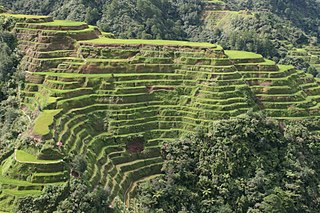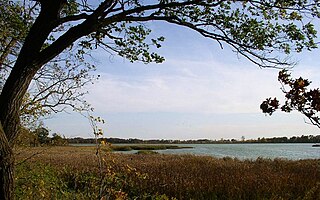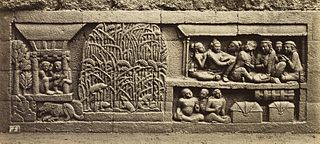
A blood sausage is a sausage filled with blood that is cooked or dried and mixed with a filler until it is thick enough to solidify when cooled. Most commonly, the blood of pigs, sheep, lamb, cow, chicken, or goose is used.

A paddy field is a flooded field of arable land used for growing semiaquatic crops, most notably rice and taro. It originates from the Neolithic rice-farming cultures of the Yangtze River basin in southern China, associated with pre-Austronesian and Hmong-Mien cultures. It was spread in prehistoric times by the expansion of Austronesian peoples to Island Southeast Asia, Madagascar, Melanesia, Micronesia, and Polynesia. The technology was also acquired by other cultures in mainland Asia for rice farming, spreading to East Asia, Mainland Southeast Asia, and South Asia.

Alto Paraná is a department in Paraguay. The capital is Ciudad del Este.

Basmati, pronounced['bɑːsmət̪iː], is a variety of long, slender-grained aromatic rice which is traditionally grown in the Indian subcontinent, mainly Bangladesh, India, Pakistan, Sri Lanka and Nepal. As of 2019, India accounted for 65% of the international trade in basmati rice, while Pakistan accounted for the remaining 35%. Many countries use domestically grown basmati rice crops; however, basmati is geographically exclusive to certain districts of India and Pakistan.

The Banaue Rice Terraces are terraces that were carved into the mountains of Banaue, Ifugao, in the Philippines, by the ancestors of the Igorot people. The terraces are occasionally called the "Eighth Wonder of the World". It is commonly thought that the terraces were built with minimal equipment, largely by hand. The terraces are located approximately 1,500 meters above sea level. These are fed by an ancient irrigation system from the rainforests above the terraces. It is said that if the steps were put end to end, it would encircle half of the globe.

Rice Lake State Park is a state park of Minnesota, United States, just east of Owatonna. Park lands entirely surround Rice Lake, an important stopping point for migrating waterfowl. The lake covers 750 acres (300 ha) with an average depth of three feet (1 m).

Yangzhou fried rice, also known by several other spellings and names, is a popular Chinese wok-fried rice dish. There are many varieties but it most properly describes egg fried rice with mixed vegetables and two forms of protein, typically pork and shrimp with scallions.

The cuisine of the Democratic Republic of the Congo and the Republic of the Congo varies widely, representing the food of indigenous people. Cassava, fufu, rice, plantain and potatoes are generally the staple foods eaten with other side dishes.

Lai fun is a short and thick variety of Chinese noodles. It is commonly found in the Pearl River Delta region and to some degree among overseas Chinatowns. Its name comes from the Cantonese language.

Pego is a municipality located in the province of Alicante, Spain.

The historic Savannah–Ogeechee Barge Canal is one of the prime relics in the history of southern canals. Beginning with the tidal lock at the Savannah River, the waterway continues through four lift locks as it traverses 16.5 miles (26.6 km), before reaching another tidal lock at the Ogeechee River at Fort Stewart. Along the way, the canal passed through Savannah’s 19th century industrial corridor, former rice fields, timber tracts, and a still lush tidal river swamp and adjacent sandhill environment that is the characteristic habitat for several unique species of flora and fauna. Nowadays much of this area comprises the Savannah suburbs of Garden City and Pooler. The canal was added to the National Register of Historic Places on August 11, 1997.

Oryza glaberrima, commonly known as African rice, is one of the two domesticated rice species. It was first domesticated and grown in West Africa around 3,000 years ago. In agriculture, it has largely been replaced by higher-yielding Asian rice, and the number of varieties grown is declining. It still persists, making up an estimated 20% of rice grown in West Africa. It is now rarely sold in West African markets, having been replaced by Asian strains.

The Ebro Delta is the delta region of the Ebro River in the southwest of the Province of Tarragona in the region of Catalonia in Spain. It is located on the Mediterranean Sea, and is the northernmost point, by some designations, of the Gulf of Valencia. Its location per Ramsar site designation is 40°43′N0°44′E.

Climate change is a critical issue in Bangladesh. as the country is one of the most vulnerable to the effects of climate change. In the 2020 edition of Germanwatch's Climate Risk Index, it ranked seventh in the list of countries most affected by climate calamities during the period 1999–2018. Bangladesh's vulnerability to the effects of climate change is due to a combination of geographical factors, such as its flat, low-lying, and delta-exposed topography. and socio-economic factors, including its high population density, levels of poverty, and dependence on agriculture. The impacts and potential threats include sea level rise, temperature rise, food crisis, droughts, floods, and cyclones.

Wajik or wajid, also known as pulut manis, is a traditional glutinous sweet made with rice, sugar and coconut milk. It is an Indonesian kue, and a kuih of Brunei, Singapore and Malaysia.
Surha, locally called Surha Taal is a natural lake located in Ballia District of Uttar Pradesh in India. It is an oval shaped lake which has an area of 34.32 km2. and is located about 17 km. north from the Ballia city along the river Ganges.

Sarawakian cuisine is a regional cuisine of Malaysia. Similar to the rest of Malaysian cuisine, Sarawak food is based on staples such as rice. There is also a great variety of other ingredients and food preparations due to the influence of the state's varied geography and indigenous cultures quite distinct from the regional cuisines of the Peninsular Malaysia. Sarawak is famous for its multi-ethnic population. As the homeland of many unique communities, Sarawak has a variety of cuisines rarely found elsewhere in Malaysia. The uniqueness of Sarawak well depends on its ethnic groups. Every native group in Sarawak has their own lifestyle, traditions, cultures and also foods. Sarawak cuisine is less spicy and has a subtle in taste. It uses fresh seafood and natural herbs like turmeric, lemongrass, ginger, lime and tapioca leaves. These ingredients are not only easily available, but also add a hint of aroma, texture and freshness to the delicacies. Food is one of the most cultural identities for native groups in Sarawak with each ethnic group having their own delicacies. Among the Iban, popular foods include tubu (stems), tuak and pansuh. The Malay have bubur pedas (porridge) and kek lapis Sarawak ; the Bidayuh have asam siok and sup ponas Bidayuh. The Melanau make tebaloi, sagu and umai and the Orang Ulu are known for garam barrio, kikid (broth), tengayen, and urum giruq (pudding).

The Siddhikali Temple is a Hindu temple located in Thimi, Nepal. The two-storey roofed temple is dedicated to Kali, Shiva and Ganesh. It is also believed that this Shaktipeeth was formed due to the falling of the right eye of the corpse of Sati. This place is located in Inayekwo, in the north west of Thimi. The temple is also known as Inayekwo Dyo in the Nepalese Bhasa language. The Siddhikali Temple is also known as Chamunda, one of the goddesses of Astamatrika. The majestically impressive Siddhikali temple has numbers of Pataa streaming down the front. There is a Satah (rest-house) opposite to the temple and multiple Falcha (Inns) and several smaller shrines to the rear and nearby, and several stone taps around the place. The artwork around the Siddhikali temple is fantastic and worth a close inspection.
Kushe is a rural municipality located in Jajarkot District of Karnali Province of Nepal.

The history of rice cultivation is an interdisciplinary subject that studies archaeological and documentary evidence to explain how rice was first domesticated and cultivated by humans, the spread of cultivation to different regions of the planet, and the technological changes that have impacted cultivation over time.



















